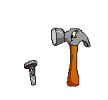After getting my first Kreg tonight
 I was wondering if using it for the cleat attachment might be a better method, due to the strength of Kreg Joints. However after trying it on scrap, I am concerned with the structural integrity of the cleat. Its not using the Kreg in the way it was designed. It seems to be strong even without glue. I would probably do a joint every 12" or so if I went this route, not 2 side by side like in the photo. I also will be using premium lumber which is cut square for the cleats instead of furring strips and attaching with Titebond II to 3/4" plywood subfloor.
I was wondering if using it for the cleat attachment might be a better method, due to the strength of Kreg Joints. However after trying it on scrap, I am concerned with the structural integrity of the cleat. Its not using the Kreg in the way it was designed. It seems to be strong even without glue. I would probably do a joint every 12" or so if I went this route, not 2 side by side like in the photo. I also will be using premium lumber which is cut square for the cleats instead of furring strips and attaching with Titebond II to 3/4" plywood subfloor.
Any thoughts? Am I over thinking this? Photos below

 ) your kreg jig. Just used one on making a face frame for a storage cabinet earlier this evening.
) your kreg jig. Just used one on making a face frame for a storage cabinet earlier this evening.

